Hosting Capacity Improvement Method Using MV–MV Solid-State-Transformer
Abstract
1. Introduction
2. Stochastic Hosting Capacity
2.1. Hosting Capacity
2.2. Stochastic Hosting Capacity Computation Method
3. Modeling and Control of SST
3.1. Modeling of the SST in OpenDSS
3.2. MV-to-MV SST in the Interconnection System
3.3. MV-to-MV SST in the Interconnection System
- -
- Step (1): Monitor the per-unit bus voltage () and line current () magnitude in the upper and lower power systems using the communication system. Where means number of the SST terminal, which is 1 or 2. and represent the bus and line number for the corresponding power systems, respectively. For example, in Figure 4, is the voltage of bus 9 in the upper power system, and there is no because bus 9 exists in the upper power system not in the lower power system.
- -
- Step (2): Using the Volt/Var curve [22], like in Figure 5, based on the largest voltage () among all buses of each power system (upper and lower power system), each terminal of the SST will absorb or supply reactive power () to the corresponding power system. Note that the reactive power of each terminal of the SST is independent.
- -
- Step (3): Control the active power flow through SST to restrain the maximum violation of the voltage or current (), which is calculated by Equation (5). If or is bigger than 1, it means that one of the power systems has at least one violation. For example, when is bigger than 1, the SST controls the active power flow from terminal “1” to terminal “2” in order to reduce the voltage magnitude or the line current in the power system on terminal “1” of the SST until becomes smaller than 1 or the active power flow reaches the active power flow limit. If case of both and are bigger than 1, SST controls the active power to reduce a bigger .where is the ampacity of the power lines.
- -
- Step (4): If the violation of voltage or current remains, control the reactive power of SST up to reactive power limit beyond the Volt/Var curve so as to mitigate violation situation.
4. Simulation Conditions and Results
4.1. Simulation Condition
4.2. Power Flow Control of SST
4.3. Effect for Hosting Capacity
5. Conclusions
Author Contributions
Funding
Institutional Review Board Statement
Informed Consent Statement
Data Availability Statement
Conflicts of Interest
References
- Ustun, T.S.; Hashimoto, J.; Otani, K. Impact of Smart Inverters on Feeder Hosting Capacity of Distribution Networks. IEEE Access 2019, 7, 163526–163536. [Google Scholar] [CrossRef]
- Luo, K.; Shi, W. Comparison of Voltage Control by Inverters for Improving the PV Penetration in Low Voltage Networks. IEEE Access 2020, 8, 161488–161497. [Google Scholar] [CrossRef]
- Collins, L.; Ward, J.K. Real and reactive power control of distributed PV inverters for overvoltage prevention and increased renewable generation hosting capacity. Renew. Energy 2015, 81, 464–471. [Google Scholar] [CrossRef]
- Long, C.; Ochoa, L.F. Voltage Control of PV Rich LV Networks: OLTC-Fitted Transformer and Capacitor Banks. IEEE Trans. Power Syst. 2016, 31, 4016–4025. [Google Scholar] [CrossRef]
- Varma, R.K.; Siavashi, E.M. Enhancement of Solar Farm Connectivity with Smart PV Inverter PV-STATCOM. IEEE Trans. Sustain. Energy 2019, 10, 1161–1171. [Google Scholar] [CrossRef]
- Divshali, P.H.; Söder, L. Improving Hosting Capacity of Rooftop PVs by Quaratic Control of an LV-Central BSS. IEEE Trans. Smart Grid 2019, 10, 919–927. [Google Scholar] [CrossRef]
- Wang, S.; Chen, S.; Ge, L.; Wu, L. Distributed Generation Hosting Capacity Evaluation for Distribution Systems Considering the Robust Optimal Operation of OLTC and SVC. IEEE Trans. Sustain. Energy 2016, 7, 1111–1123. [Google Scholar] [CrossRef]
- Nursebo, S.S.; Chen, P.; Carlson, O.; Bertling Tjernberg, L. Optimizing Wind Power Hosting Capacity of Distribution Systems Using Cost Benefit Analysis. IEEE Trans. Power Delivery 2014, 29, 1436–1445. [Google Scholar] [CrossRef]
- Quijano, D.A.; Wang, J.; Sarker, M.R.; Padilha-Feltrin, A. Stochastic assessment of distributed generation hosting capacity and energy efficiency in active distribution networks. IET Gener. Trans. Distrib. 2017, 11, 4617–4625. [Google Scholar] [CrossRef]
- Lee, J.; Bérard, J.-P.; Razeghi, G.; Samuelsen, S. Maximizing PV hosting capacity of distribution feeder microgrid. Appl. Energy 2020, 269, 114400. [Google Scholar] [CrossRef]
- Ismael, S.M.; Abdel Aleem, S.H.E.; Abdelaziz, A.Y.; Zobaad, A.F. State-of-the-art of hosting capacity in modern power systems with distributed generation. Renew. Energy 2019, 130, 1002–1020. [Google Scholar] [CrossRef]
- Ding, F.; Mather, B. On Distributed PV Hosting Capacity Estimation, Sensitivity Study, and Improvement. IEEE Trans. Sustain. Energy 2017, 8, 1010–1020. [Google Scholar] [CrossRef]
- Sousa, J.F.B.; Borges, C.L.T.; Mitra, J. PV hosting capacity of LV distribution networks using smart inverters and storage systems: A practical margin. IET Renew. Power Gener. 2020, 14, 1332–1339. [Google Scholar] [CrossRef]
- Costa, L.F.; De Carne, G.; Buticchi, G.; Liserre, M. The Smart Transformer: A solid-state transformer tailored to provide ancillary services to the distribution grid. IEEE Power Electron. Mag. 2017, 4, 56–67. [Google Scholar] [CrossRef]
- Mainali, K.; Tripathi, A.; Madhusoodhanan, S.; Kadavelugu, A.; Patel, D.; Hazra, S.; Hatua, K.; Bhattacharya, S. A Transformerless Intelligent Power Substation: A three-phase SST enabled by a 15-kV SiC IGBT. IEEE Power Electron. Mag. 2015, 4, 31–43. [Google Scholar] [CrossRef]
- Lee, H.D.; Tae, D.H.; Kim, J.M.; Rho, D.S. Evaluation Method for Hosting Capacity of PV System in Distribution System with Micro Hydropower Generator. J. Electr. Eng. 2020, 15, 2489–2499. [Google Scholar] [CrossRef]
- Arshad, A.; Lehtonen, M. A Stochastic Assessment of PV Hosting Capacity Enhancement in Distribution Network Utilizing Voltage Support Techniques. IEEE Access 2019, 7, 46461–46471. [Google Scholar] [CrossRef]
- Abad, M.S.S.; Ma, J.; Zhang, D.; Ahmadyar, A.S.; Marzooghi, H. Probabilistic Assessment of Hosting Capacity in Radial Distribution Systems. IEEE Trans. Sustain. Energy 2018, 9, 1935–1947. [Google Scholar] [CrossRef]
- Torquato, R.; Salles, D.; Pereira, C.O.; Magalhaes Meira, P.C.; Freitas, W. A Comprehensive Assessment of PV Hosting Capacity on Low-Voltage Distribution Systems. IEEE Trans. Power Deliv. 2018, 33, 1002–1012. [Google Scholar] [CrossRef]
- Sanduleac, M.; Martins, J.F.; Ciornei, I.; Albu, M.; Toma, L.; Fernao Pires, V.; Hadjidemetriou, L.; Sauba, R. Resilient and Immune by Design Microgrids Using Solid State Transformers. Energies 2018, 11, 3377. [Google Scholar] [CrossRef]
- Guerra, G.; Martinez-Velasco, J.A. A Solid State Transformer Model for Power Flow Calculations. Electr. Power Energy Syst. 2017, 89, 40–51. [Google Scholar] [CrossRef]
- Hwang, J.H.; Lim, S.G.; Choi, M.S.; Kim, M.S. Reactive Power Control Method for Grid-Tie Inverters Using Current Measurement of DG Output. J. Electr. Eng. 2019, 14, 603–612. [Google Scholar] [CrossRef]
- Castelo de Oliveira, T.E.; Bollen, M.; Ribeiro, P.F.; de Carvalho, P.M.S.; Zambroni, A.C.; Bonatto, B.D. The Concept of Dynamic Hosting Capacity for Distributed Energy Resources: Analytics and Practical Considerations. Energies 2019, 12, 2576. [Google Scholar] [CrossRef]
- Jain, A.K.; Horowitz, K.; Ding, F.; Sedzro, K.S.; Palmintier, B.; Mather, B.; Jain, H. Dynamic hosting capacity analysis for distributed photovoltaic resources—Framework and case study. Appl. Energy 2020, 280, 115633. [Google Scholar] [CrossRef]
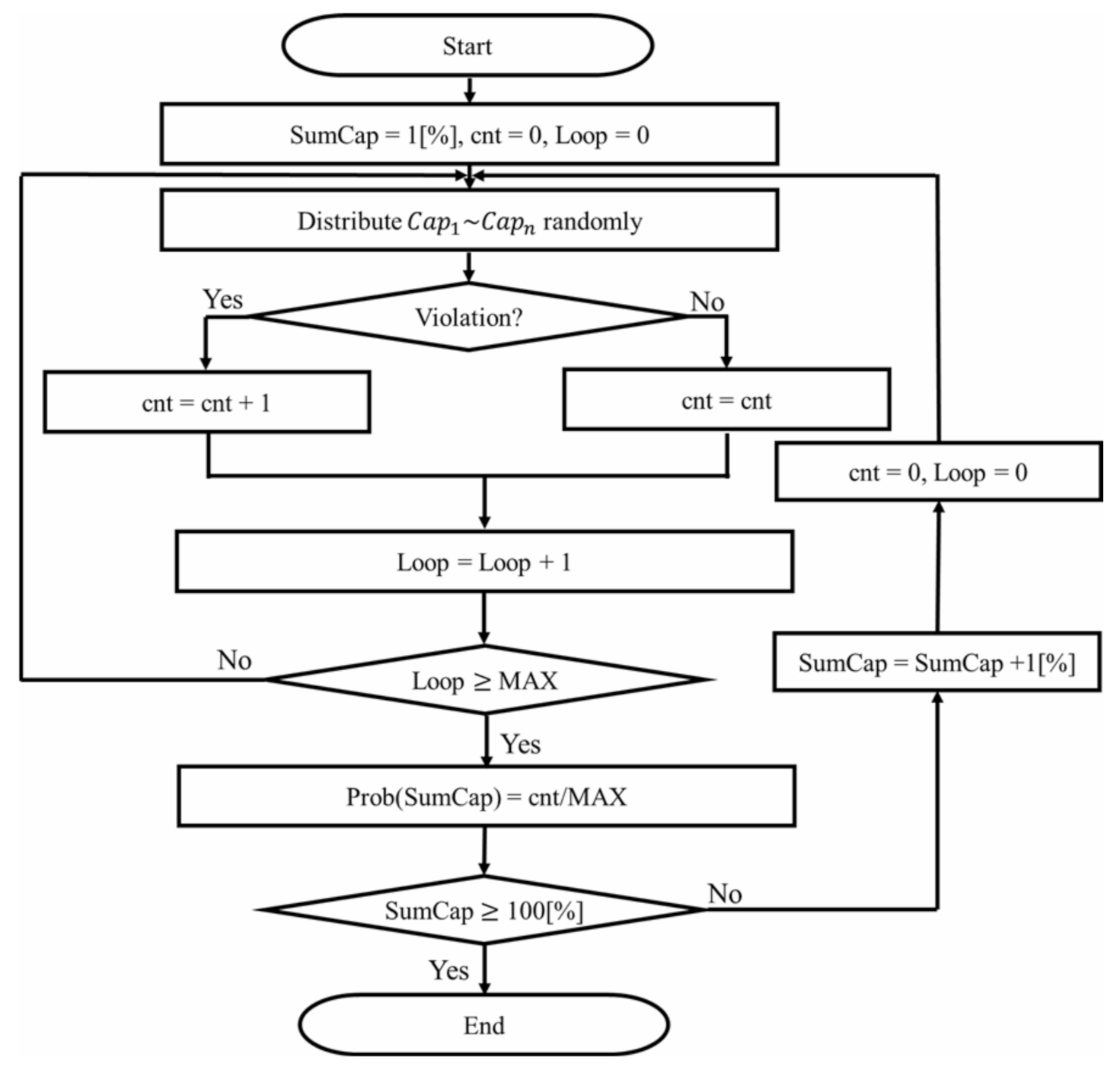


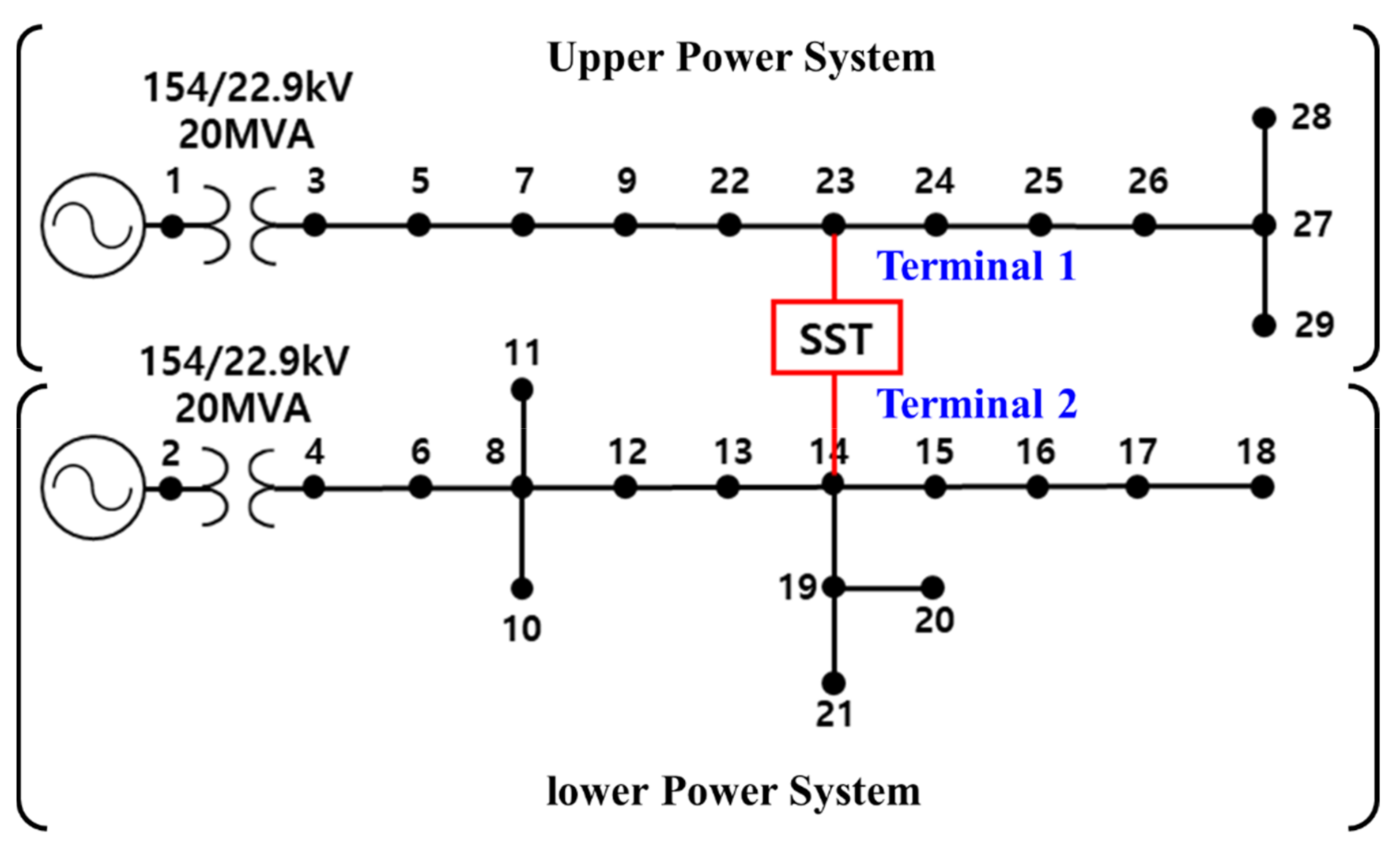
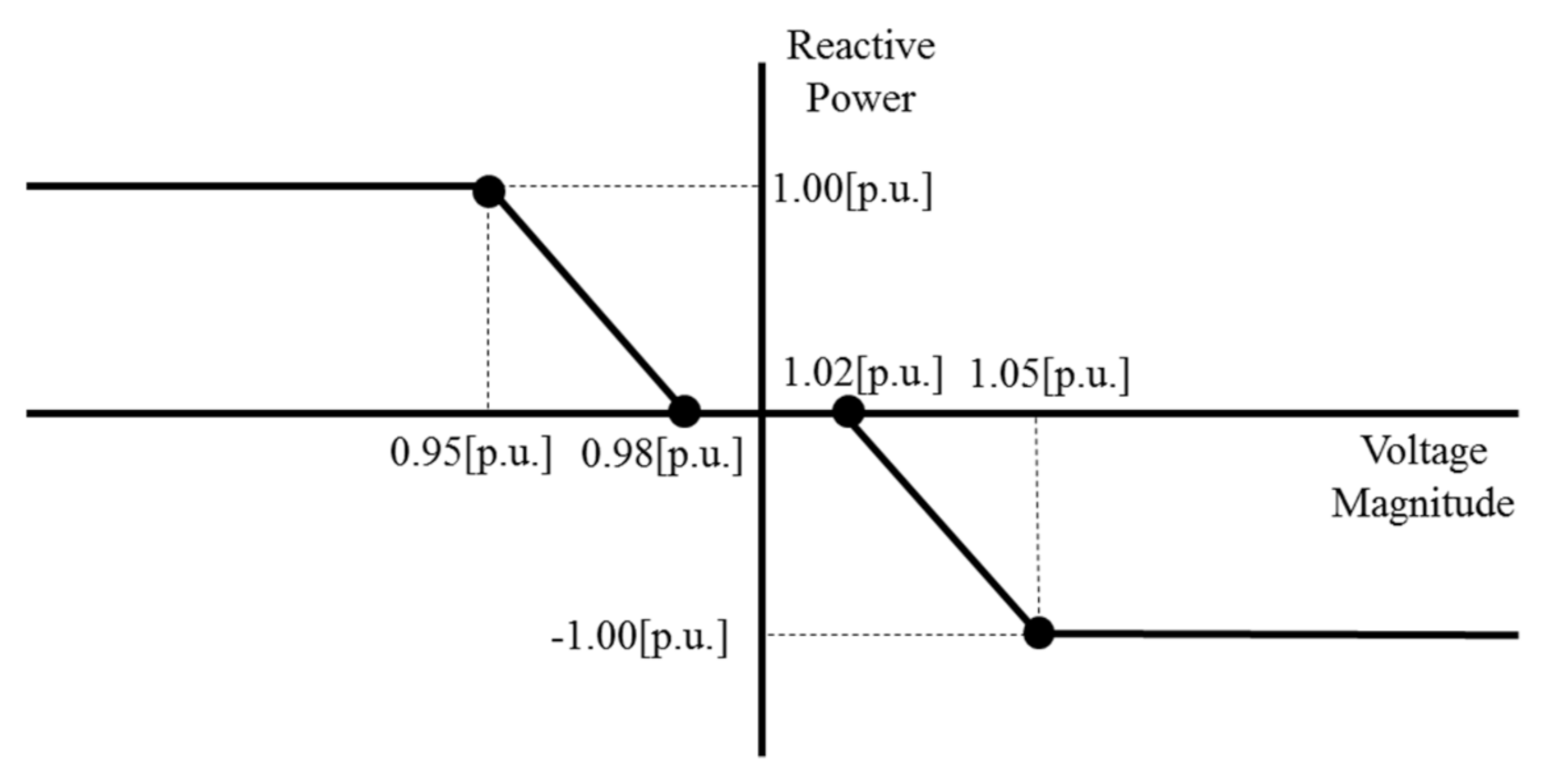
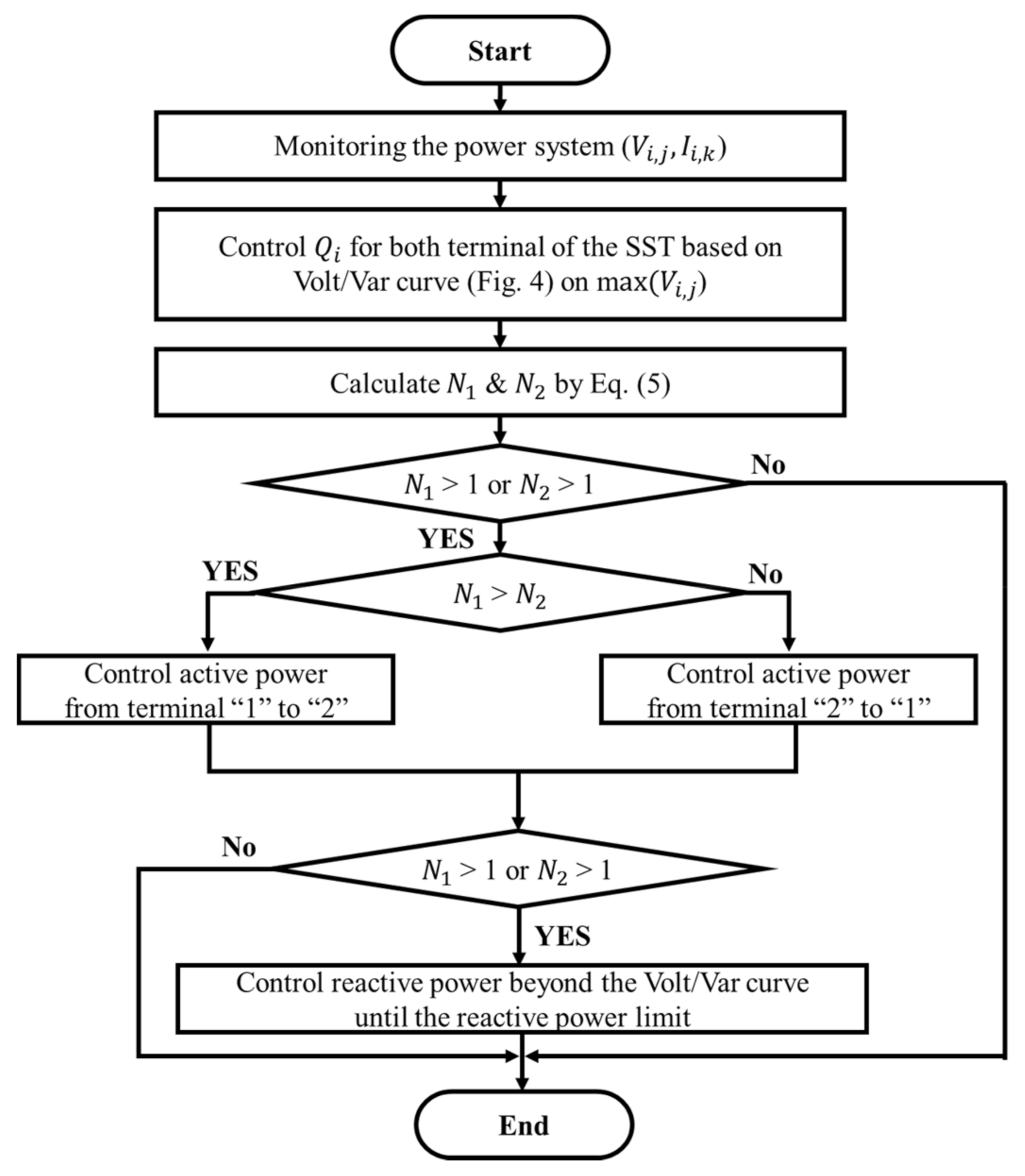

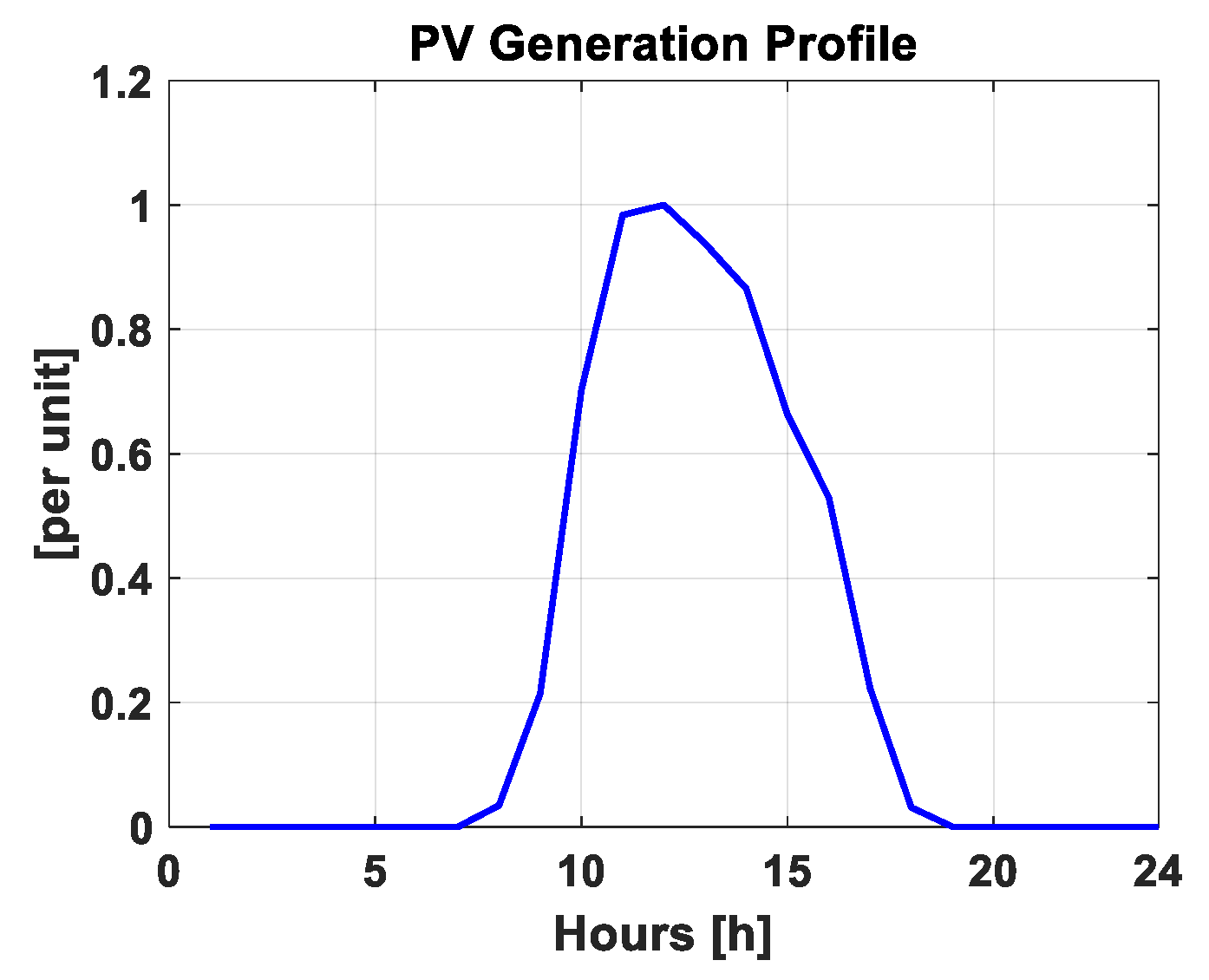
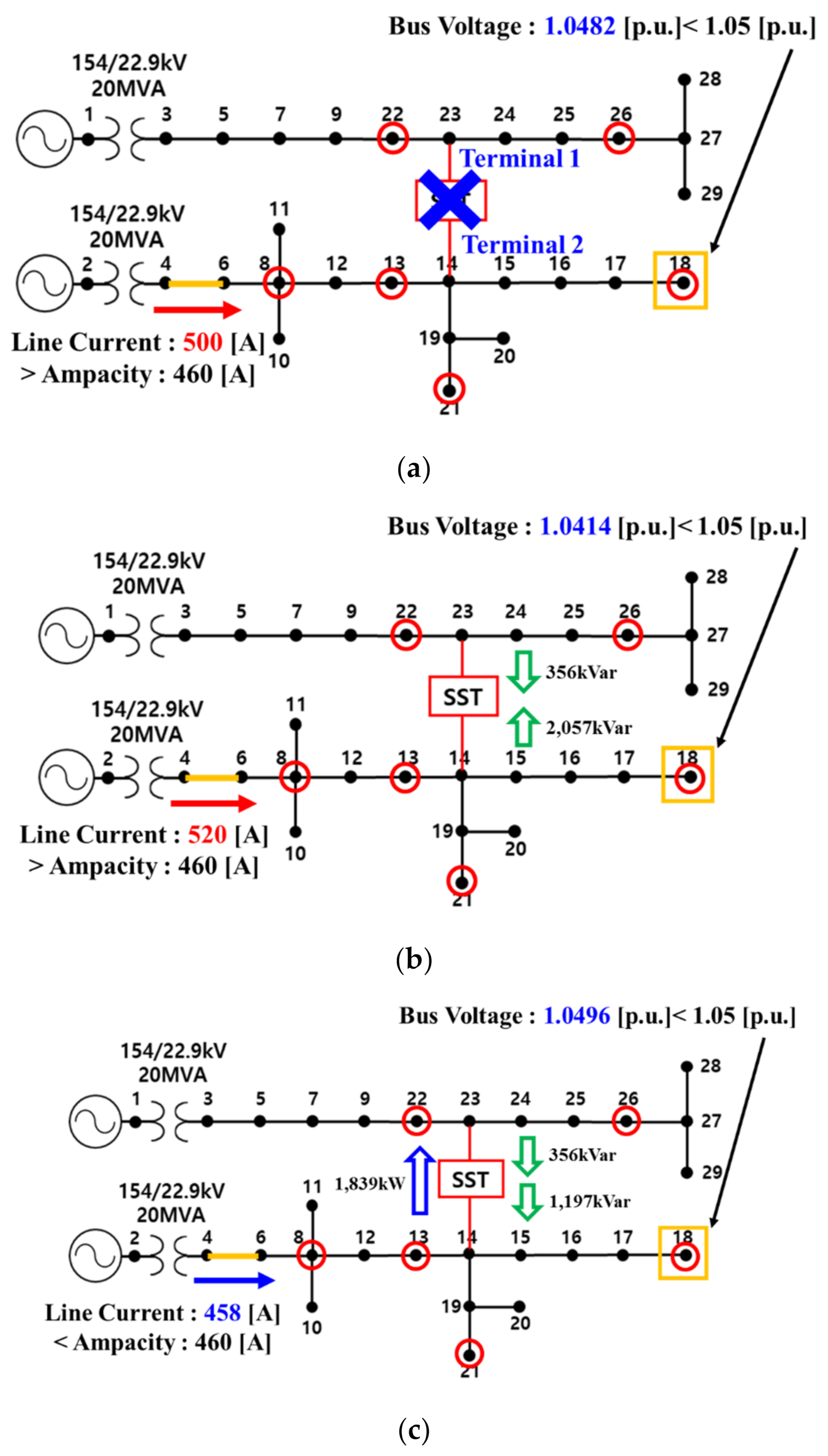
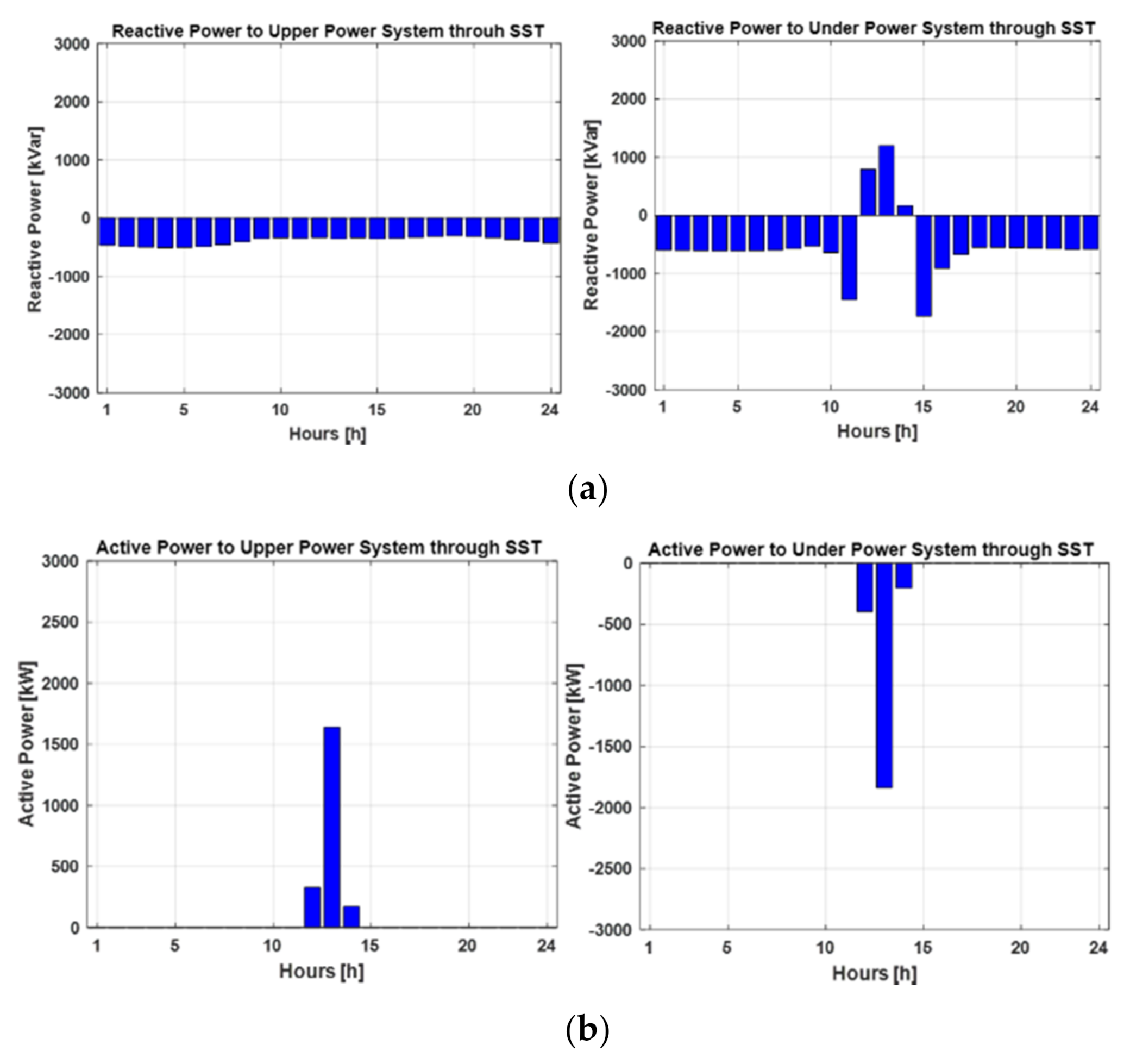
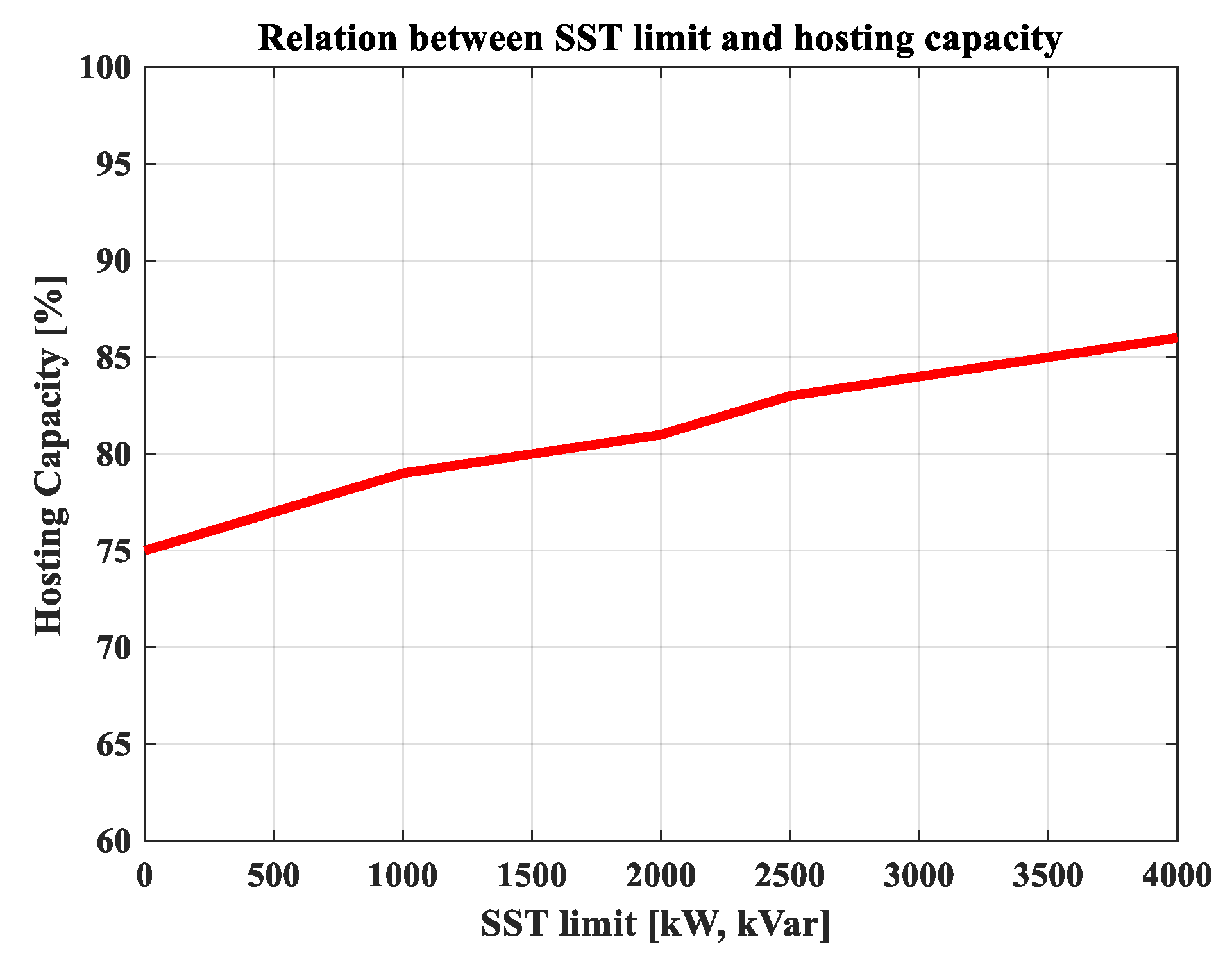
| Load | Load Locations (Bus) |
|---|---|
| Type I | 9, 10, 12, 20, 22, 26 |
| Type II | 3, 4, 7, 11, 13, 16, 17, 18, 19, 21, 24 |
| Type III | 5, 6, 8, 14, 15, 23, 25 |
| Power Limit of SST: 3000 kW + j3000 kVar | ||||||
|---|---|---|---|---|---|---|
| Bus | Lower Power System | Upper Power System | ||||
| 8 | 13 | 18 | 21 | 22 | 26 | |
| PV | 4500 kVA | 1930 kVA | 6200 kVA | 1200 kVA | 1700 kVA | 300 kVA |
| Penetration Level [%] | 70 | 71 | 72 | 73 | 74 | 75 | 76 | 77 | 78 | 79 | 80 | 81 | 82 | 83 | 84 | 85 | 86 |
|---|---|---|---|---|---|---|---|---|---|---|---|---|---|---|---|---|---|
| 1. No SST | 1.9 | 2.2 | 2.6 | 2.2 | 4.1 | 5.8 | 5.8 | 6.1 | 8.6 | 9.6 | 11.9 | 10.5 | 14.9 | 14 | 14.1 | 18.4 | 20.1 |
| 2. SST (500) | 1.7 | 1.8 | 2 | 1.6 | 2.9 | 3 | 3.7 | 5.6 | 6.7 | 5.9 | 8.2 | 9 | 11.5 | 12 | 14 | 13.5 | 17 |
| 3. SST (1000) | 1 | 0.9 | 1.6 | 2.1 | 2.9 | 3.3 | 2.6 | 4.4 | 4.6 | 6.4 | 7.2 | 6.6 | 9.7 | 10 | 11.4 | 10.2 | 13.8 |
| 4. SST (1500) | 0.6 | 0.9 | 1 | 1.2 | 1.5 | 2.4 | 2 | 2.5 | 3.5 | 4.4 | 5.8 | 5.7 | 7.5 | 7.4 | 8.8 | 11.8 | 9.9 |
| 5. SST (2000) | 0.8 | 0.5 | 0.7 | 0.4 | 1.3 | 1.4 | 2.3 | 2.6 | 2.5 | 4 | 4.4 | 5.2 | 5.7 | 6.9 | 8.6 | 8.9 | 10 |
| 6. SST (2500) | 0.8 | 0.4 | 0.7 | 0.4 | 1.2 | 1.4 | 1.4 | 2.1 | 2.7 | 3.1 | 2.7 | 3.9 | 4.2 | 6.5 | 7.3 | 6.8 | 7.5 |
| 7. SST (3000) | 0.4 | 0.5 | 0.5 | 1 | 1 | 1.1 | 0.6 | 1.1 | 1.5 | 3.4 | 3.3 | 3.7 | 4.3 | 4.9 | 6.1 | 7.4 | 8.6 |
| 8. SST (3500) | 0.1 | 0.3 | 0.6 | 0.1 | 1.1 | 1 | 1 | 0.7 | 2.2 | 2.4 | 3.6 | 3.2 | 4.3 | 4.2 | 3.7 | 5.8 | 6.3 |
| 9. SST (4000) | 0.8 | 0.2 | 0.4 | 0.7 | 0.8 | 0.9 | 1.4 | 1.3 | 1.2 | 2.1 | 1.9 | 2.7 | 2.4 | 3.8 | 2.5 | 3.9 | 6.8 |
| 10. Volt/Var | 5.6 | 5.6 | 7.2 | 7.7 | 10.4 | 11.1 | 10.4 | 13.8 | 17.3 | 15.7 | 18.3 | 22.7 | 24.3 | 26.1 | 23 | 26.4 | 28.7 |
Publisher’s Note: MDPI stays neutral with regard to jurisdictional claims in published maps and institutional affiliations. |
© 2021 by the authors. Licensee MDPI, Basel, Switzerland. This article is an open access article distributed under the terms and conditions of the Creative Commons Attribution (CC BY) license (http://creativecommons.org/licenses/by/4.0/).
Share and Cite
Song, J.-S.; Kim, J.-S.; Mather, B.; Kim, C.-H. Hosting Capacity Improvement Method Using MV–MV Solid-State-Transformer. Energies 2021, 14, 622. https://doi.org/10.3390/en14030622
Song J-S, Kim J-S, Mather B, Kim C-H. Hosting Capacity Improvement Method Using MV–MV Solid-State-Transformer. Energies. 2021; 14(3):622. https://doi.org/10.3390/en14030622
Chicago/Turabian StyleSong, Jin-Sol, Ji-Soo Kim, Barry Mather, and Chul-Hwan Kim. 2021. "Hosting Capacity Improvement Method Using MV–MV Solid-State-Transformer" Energies 14, no. 3: 622. https://doi.org/10.3390/en14030622
APA StyleSong, J.-S., Kim, J.-S., Mather, B., & Kim, C.-H. (2021). Hosting Capacity Improvement Method Using MV–MV Solid-State-Transformer. Energies, 14(3), 622. https://doi.org/10.3390/en14030622








